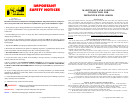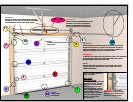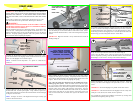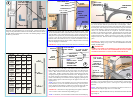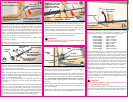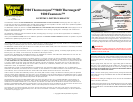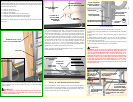
IMPORTANT
SAFETY NOTICES
Read these instructions carefully before attempting installation. If in question about any of the proce-
dures, do not perform the work. Instead, have a qualified door agency do the installation or repairs.
1. Wear protective gloves during installation to avoid possible cuts from sharp metal edges.
2. It is always recommended to wear eye protection when using tools, otherwise serious eye injury
could result.
3. Avoid installing your new door on windy days. Door could fall during the installation and cause
damage and personal injury.
4. If the door is to be electrically operated at any time, all pull ropes MUST be removed to prevent
injury or death to children who may become entangled in the rope. The locking mechanism MUST also
be disengaged.
5. Operate door ONLY when properly adjusted and free of obstructions.
6. Should the door become hard to operate or completely inoperative, a qualified door agency should
correct the problem to prevent damage to the door or serious personal injury.
7. DO NOT PERMIT children to play with the garage door or the electrical controls. Fatal injury
could result, should the child become entrapped between the door and the floor.
8. To prevent serious injury or death, avoid standing in the open doorway or walking through the
doorway while the door is moving.
9. Door is constantly under EXTREME SPRING TENSION. To prevent possible serious injury or
death, adjustments, repairs, removal or installation, ESPECIALLY of SPRING ASSEMBLIES,
CABLES or BOTTOM CORNER BRACKETS, should be performed ONLY by qualified door ser-
vice people.
10. If your existing garage door opener does not have a reversing mechanism, you should consider
purchasing one that has up to date safety features. These features can prevent opener related property
damage or personal injury.
11. Check all bolted connections monthly during the lifetime of the door to prevent damage or personal
injury caused by loose connections.
12. Definition of key words used in this manual:
WARNING! -- Indicates a potentially hazardous situation which, if not avoided, could result
in serious injury or death.
IMPORTANT! -- Required step for safe and proper door operation.
NOTE: -- Information assuring proper installation of the door.
©
Copyright 2002 Wayne-Dalton Corp.
Wayne-Dalton Corp.
P.O. Box 67
Mt. Hope, Ohio 44660
©
Copyright 2002 Wayne-Dalton Corp.
MAINTENANCE AND PAINTING
INSTRUCTION FOR
PREPAINTED STEEL DOORS
MAINTENANCE
While factory-applied finishes for steel garage doors are so durable that they will last many years longer than ordinary
paints, it is desirable to clean them thoroughly on a routine basis. Apparent discoloration of the paint may occur when
it has been exposed in dirt-laden atmospheres for long periods of time. Slight chalking may also cause some change in
appearance in areas of strong sunlight. A good cleaning will generally restore the appearance of these coatings and render
repainting unnecessary. An occasional light cleaning will also help maintain an aesthetically pleasing appearance. To
maintain the original finish of the garage doors, the only regular maintenance necessary is that of annual washing. Mild
solutions of detergents or household ammonia will aid in the removal of most dirt, and the following are recommended
levels:
One cup of Tide, or other common detergents, which contain less than 0.5% phosphate, dissolved into five
gallons of warm water. NOTE: The use of detergents containing greater than 0.5% phosphate is not recommended
for use in general cleaning of garage doors. CAUTION: NEVER MIX CLEANSERS OR DETERGENTS WITH
BLEACH.
SURFACE PREPARATION FOR PAINTING
Wax on the surface must be removed or paint peeling/flaking will result. To remove this wax, it will be necessary to
lightly scuff the surface with a gray (not green!) 3M ScotchBrite pad saturated with soapy water. A final wipe and rinse
should be done with clean water only, to remove any loose dust or soap film.
Surface scratches, which have not exposed the metal substrate, can be lightly buffed or sanded with 0000 steel wool or
No. 400 sand paper to create a smoother surface. Care must be taken to not expose the substrate under the paint (see
Note No. 2). Once this exposed condition exists, the likelihood for rusting is greatly increased. See the following
paragraph if the metal substrate is observed.
Exposed substrate must be treated to prevent rust from forming (see Note No. 2). Sand the exposed area lightly and
paint with high quality metal primer to protect from corrosion. Follow drying time on primer can label before applying
topcoat.
The surface to be recoated must not be to smooth or the repaint material will not adhere to it (see Note No. 2). It is
advisable to test a representative area to evaluate adhesion. If poor adhesion is observed, the surface must be abraded by
sanding or buffing using grades mentioned above. Care must be taken to not expose the substrate under the paint.
PAINTING
After the surface has been properly prepared it must be allowed to dry thoroughly, then coated immediately with a
premium quality latex house paint. Follow the paint label directions explicitly. Oil base paint is not recommended.
Please note that if substrate is exposed, painting with latex paint may cause accelerated rusting of steel.
NOTES:
1. Repainting of finish painted steel doors cannot be warranted as this condition is totally beyond door
manufacturers control.
2. If the steel door surface has a finish painted textured surface representing wood grain, stucco, etc., this step
should not be attempted as danger of exposing substrate is greatly increased.
3. Consult a professional coatings contractor if in doubt about any of the above directions.
4. Follow directions explicitly on the paint and solvent container labels for proper applications of coatings
and disposal of containers. Pay particular attention to those directions involving acceptable conditions in which to
paint.
ACRYLIC GLAZING CLEANING INSTRUCTIONS:
1. To clean acrylic glazing wash with plenty of nonabrasive soap or detergent and water. Use the bare hand to
feel and dislodge any caked dirt or mud. A soft, grit-free cloth, sponge or chamois may be used to wipe the surface.
Do not use hard or rough cloth that will scratch the acrylic glazing. Dry with a clean damp chamois.
2. Grease and oil may be removed with kerosene or a good grade of naphtha (No aromatic content.). Users of
these solvents should become familiar with their properties to handle them safely.
3. Do not use: Window cleaning fluids, scouring compounds, gritty cloths, leaded or ethyl gasolines, or solvents
such as alcohol, acetone, carbon tetrachloride, etc.




